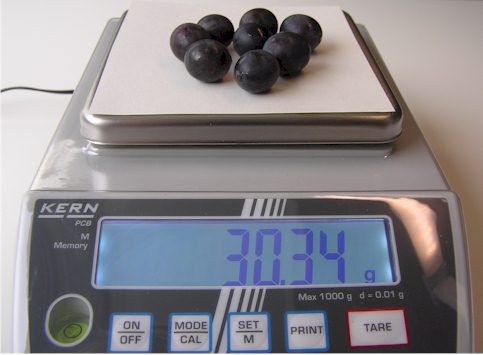 If you buy 1 kg of plums at the market, you don’t need to think about the weight. But sometimes the reference is important, at least when products differ significantly in their water content. Whether the price for 100 g of mushrooms in the online store refers to fresh weight or dry weight makes a big difference. This applies to many vegetable products.
If you buy 1 kg of plums at the market, you don’t need to think about the weight. But sometimes the reference is important, at least when products differ significantly in their water content. Whether the price for 100 g of mushrooms in the online store refers to fresh weight or dry weight makes a big difference. This applies to many vegetable products.
Term & Definition
Colloquially, fresh weight is the weight of a sample in fresh condition. However, this definition is not sufficient for a value reference of measurands: biological samples lose weight over time due to evaporation or other release of water.
The fluctuations in the water balance vary from species to species. Spruce needles, for example, have an epidermis that is only slightly permeable to water, and fluctuations in water content are correspondingly small. The fruiting bodies of many fungal species, on the other hand, can show significant differences in water content within hours.
Therefore, for scientific purposes, the fresh weight is usually determined immediately after the sample has been taken. Alternatively, in particularly sensitive cases, measures are taken to minimize water loss from the sample during transport. This can be done, for example, by cooling the sample with ice or, in extreme cases, liquid nitrogen.
Abbreviation: Fresh weight versus fresh substance
Fresh weight is abbreviated as FM (English FW for Fresh Weight). In science, the term fresh substance is also commonly used, which is abbreviated as FS.
Calculation & Formula
To convert dry matter to fresh matter, the weight of escaped water must be added to the dry matter:
Fresh Weight [g] = Dry Weight [g] + Lost Water Content [g].
If the water content is not known, it can be researched in publications.
In figure 1 the fresh substance of grapes are determination with a laboratory scale. The value is 30,34 g, but the dry weight is just 5,77 g. About 81% of the composition of grapes is only water.

Abb. 1: Example of FM determination of grapes
Fresh mass and food
Colloquially, fresh weight is also referred to as the weight of a sample in its fresh state. However, this definition is not sufficient for a value reference of measurands. Due to evaporation or other release of water, biological samples lose weight over time.
These fluctuations in the water balance vary from feed to feed. Plants with a less water-permeable epidermis have correspondingly smaller fluctuations in water content. The fruiting bodies of many fungal species, on the other hand, can show significant differences in water content within hours. Therefore, for scientific purposes, the fresh weight is usually determined immediately after the sample has been taken. Alternatively, in particularly sensitive cases, measures are taken to minimize water loss from the sample during transport. This can be done, for example, by cooling the sample with ice or, in extreme cases, liquid nitrogen.
In the declaration of dried food (e.g. for dogs), the values listed under “Content of ingredients” or “Analysis” always refer to the so-called dry matter (TS). This refers to the portion of a feed remaining after drying (dry matter = fresh matter – raw water).
In the case of wet feed, the values are declared under “Content of ingredients” or “Analysis” in relation to the so-called fresh mass or fresh substance (FS). This is the original substance of a feed, which results from the proportion of dry matter plus raw water (fresh matter = raw water + dry matter).
Dry feed has a water content of approx. 8-10%
As a rule, dry feed has a water content of approx. 8-10%, wet feed a content of approx. 70-78%. In order to compare analytical values such as crude protein and crude fat, it is common practice to convert the values of the wet feed from the fresh substance to the dry substance. This is also very important, because at first sight each can seems to be lower in protein and fat than each dry food. However, most of the time it is exactly the opposite.
Literature
Fresh-weight measurements of roots provide inaccurate estimates of the effects of plant growth-promoting bacteria on root growth: a critical examination. Abstract
German Corn Committee – Conversion of wet to dry product
Details of the FM of deer truffles
Precise, Real-time Measurement of the Fresh Weight of Lettuce with Growth Stage in a Plant Factory using a Nutrient Film Technique. Link
Significance of fresh weight to dry cell weight ratio in plant cell suspension cultures. Text
